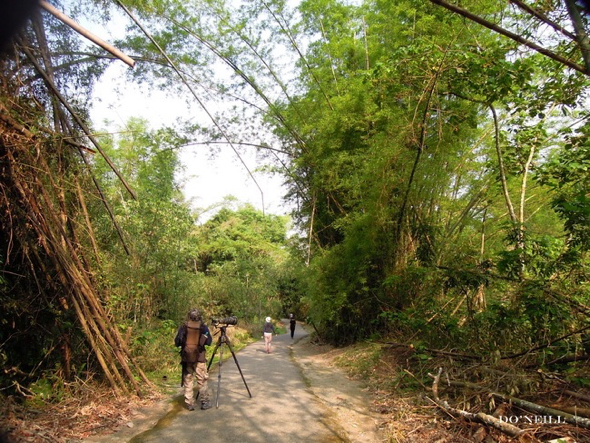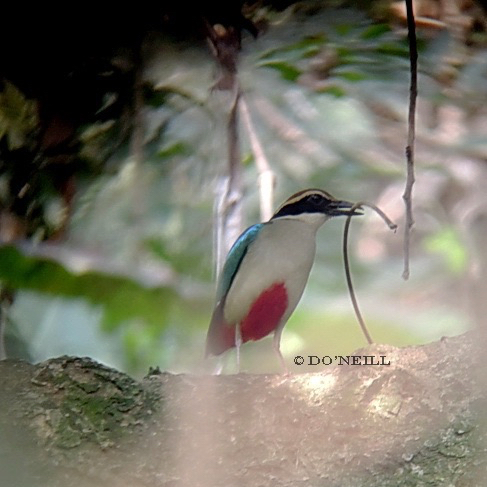Birding Highlights of Taiwan 2017 Series
“I surveyed every area of Huben – an agricultural based village, wherever pedal power took me. Small fruit plantation holdings of bananas, pineapples, dragon fruits, papayas, oranges and limes, coffee trees and modest vegetable plots were areas where bird species potentially foraged were not spared.
“An undulating terrain of slopes, gullies, streams and river course, ample bamboo grove forests, some interspaced with mixed growth of deciduous trees and broad-leaved evergreen forests in a sub-tropical region, is ideal habitat for breeding Fairy Pittas (Pitta nympha).
“I was beginning to feel rather concerned- having spent seven days, only two days left remaining and having scoured Huben Ecovillage – my time to see a nympha bird in the wild still had not arrived (above).
“When news eventually came through that there had been ‘Pak Sik Neo’ sightings at a popular local park nearby, Manageress Yao was kind to drop me off early next morning, before any bird photographers showed.
“I walked the main trail of bamboo forests (above).
“The calls of a breeding pair of Fairy Pitta soon rang out from bamboo forests, a distance away. Two syllable calls, ‘kwah-he, kwa-wu’ grew louder and louder as I inched my way up trail.
“Breeding calls of nympha bird grew noisy in tandem with distracting courtesy – exchange greetings from morning walkers/joggers at the popular public park.
“A pitta bird was so close to show until first bird-photographer appeared and set off his pre-recorded, blasting calls of Pitta nympha in the direction, where bird called. The result… alarmed bird fled. So was my sighting.
“Back to square one but with a difference.
“Two Swedish birders/photographers checked in at Pitta Café same evening and pre-booked their bird guide. They were God sent. Before the next day was over, friendship in birding fraternity soon paid off. I received a positive bird location tip off before they happily left having sighted the bird they came specifically for.
“Zooming in on a positive sighting area was certainly great help. While my imitating whistled calls were not loud and powerful enough to get the attention of any Pitta nympha, I took comfort in knowing, I need not have to waste time nor pedal power further to seek out other sites.
“A second God sent opportunity came in the form of a British couple same evening. A quick drive around paid off prior checking into accommodation. A pitta bird was heard calling it seemed.
“Enthusiasm, skilful birding/ excellent field craft had this keen and hard cored, Newcastle bird twitcher awoke at predawn (0430hrs) and successfully located birding site. Bird was observed foraging breakfast of vermin on a slope.
“The breeding pair of Fairy Pitta was still around when generously showed birds’ location and findings same morning.
“We took to a slope of thick ground cover, overlooking a shallow gully with caladium plant species as natural hide. There were tall trees around and tree canopy dimmed by heavy foliages. When not foraging, it appeared these breeding birds spent time on trees and difficult to spot when remained still.
“We had arrived at entrance to Pitta nympha’s breeding territory. Brief observations made, a small window of opportunity for DGscope was had no less than 30m away, up on a horizontal branch, before nest builder disappeared amongst the tree canopy (above).
“Nesting has begun for this Fairy Pitta Day logged in – 4th May, 2017.
“The next morning, with pedal power, I revisited breeding site one more time and hid amongst those huge caladium foliages and waited. Nothing appeared.
“As it was not my habit to use playback bird call recordings, I took to a few whistling calls. Maybe my pitch was not perfect nor the volume sufficient to get any attention. Another fifteen minutes into the waiting, I had enough and decided to stand up and see all or be seen. ‘Surrender…’
“Forest was so… quiet but sensed I was being watched. As I turned to leave, a green bird suddenly flew in from nowhere and landed on ground cover, about three meters from me. I took to quick squat position and slowly raised by binoculars to fixed eyeball position on the bird.
“Not another dove misidentified but a bird with red vent, that peeped from a crouched position, suggested it to be the long awaited bird I had come to see….Pitta nympha.
“‘Ah…..it’s about time you showed!’
“Frozen in squat position and bird played dead, I made the first move and waddled slowly in agony towards DGscope- who by then, felt divorced from me, while my eyes were locked onto the bird. I held 3rd eyed partner with its feet and eventually rose in slow motion.
“By then, I had lost sight of the bird. No indication bird had flown. Fairy Pitta simply had ‘melted’ into ground cover.
“It appeared, most Avian writer was able to do was to whistle a Pitta nympha down a tree and the nearest this fairy bird allowed… was that few seconds of a near view in squat position and vanished.
“Perhaps in doing so, justifies in living up to its name… ‘Fairy’.
“So to my visit to Huben Ecovillage of Pitta nympha came to a fruitful end.”
Avian Writer Daisy O’Neill
Penang, Malaysia
9th September 2017
Copyright article and all copy images – Courtesy of Daisy O’Neill Bird Conservation Fund
Appreciation and thanks – in alphabetical order: Frederick (Sweden), Mike & Denise Hunter (UK), Steven (Sweden), Ms. Yao (Pitta Café, Huben)












One Response
Great story. Good reading. Thanks!